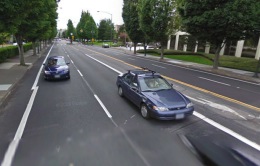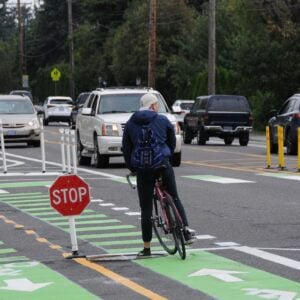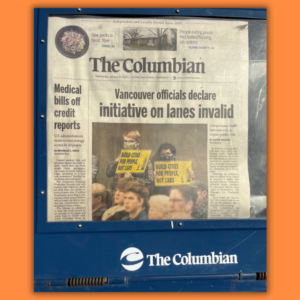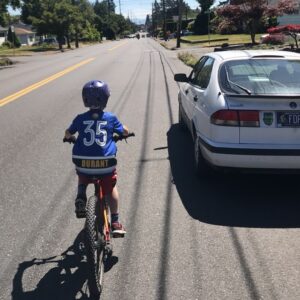
District could be going on a diet.
It’s been over two months since we last reported on the NE Holladay Street project. Remember that one? Part of a trio of Lloyd District Bikeway Development Projects, it was supposed to make NE Holladay an east-west arterial for bike traffic to connect inner northeast neighborhoods (and eventually the Sullivan’s Gulch path) through the Lloyd District all the way to the Willamette River.
But after a public process on the Holladay project fizzled out amid confusion and uncertainty back in October, a new effort pushed by a lone dissenting stakeholder who didn’t want major changes on Holladay appears to have successfully shifted the focus to NE Multnomah Street.
The Lloyd District Transportation Management Association (TMA) is now set to meet with PBOT and stakeholders later this month to launch a new process that will consider putting Multnomah on a road diet.
Let’s rewind for some background…
“We’ve been presented with an opportunity to implement some near-term changes to the right-of-way on Multnomah Street.”
— Rick Williams, Executive Director of Lloyd TMA
After a lengthy public process that began one year ago today, the Holladay project’s stakeholder advisory committee voted 12-1 to move forward with a proposal that would have made significant progress toward improving bike access by re-configuring on-street parking to make a two-way dedicated bikeway (it wasn’t the carfree proposal that we started with, but it was a big improvement).
However, despite that vote, no forward progress was taken on Holladay because that lone “no” vote happened to belong to Ashforth Pacific, a large real estate firm that holds several properties along Holladay and holds considerable sway with the Lloyd District and in City Hall.
Ashforth Pacific VP Wade Lang and the stakeholder representing the Rose Garden/Trail Blazers, Justin Zeulner, had long urged the City to give up on improving bike access on Holladay and instead look at NE Multnomah (an arterial one block north) — despite the fact that the scope of the public process never included Multnomah and despite a study by project consultants that deemed Holladay the best candidate for east-west bike improvements.
Unknown to even some members of the stakeholder committee, Ashforth had been communicating with PBOT about improvements to Multnomah before the vote back in October. After the 12-1 in favor of Holladay, Ashforth reps, the Lloyd Transportation Management Association, and PBOT cut a deal to do a traffic analysis on Multnomah to see if changes to it would be feasible.
“They’ve asked us to look at Multnomah as a possible alternative to Holladay,” commented PBOT Director Tom Miller at the time, “and they’re willing to fund a traffic count analysis, so we’re looking at that.”
Now, according to an email we’ve received from someone close to the project, Ashforth has gotten their wish.
“We’ve been presented with an opportunity to implement some near-term changes to the right-of-way on Multnomah Street,” reads an email from Lloyd TMA Executive Director Rick Williams to PBOT and a selected list of project stakeholders.
The email continues (emphasis mine):
“This opportunity came about through the coalescing of a number of developments including an emerging concept in the N/NE Quadrant Plan process that identifies Multnomah as a “retail, main street”, preliminary traffic analysis conducted by PBOT which indicates some of the road space on Multnomah could be reallocated without adverse impacts on traffic, and the continued interest in establishing a high-quality, east-west bike route through the district stemming from the Lloyd Bikeways projects.”
Williams’ email goes on to say they want to establish a “Multnomah Action Committee” in order to “take a holistic look at all transportation modes along Multnomah and potentially recommend changes to the roadway based on consensus.”
I called Williams this morning to confirm the email and their plans for Multnomah. Williams confirmed they are looking at a “re-purposing” of Multnomah. He also said the new process will be led by his TMA, not the City of Portland.
Williams told me this morning that he plans to convene a meeting this month to “take a high level look” at the potential of the project. No funding has been identified yet, but the likely scenarios would be adding back on-street parking and re-allocating roadway space in an attempt to revitalize the street.
According to Williams, Multnomah has been in their sights for a redesign for many years. He said it’s “a boulevard, but not attractive to ground-level businesses.”
Asked about a timeline and opportunities for public involvement with this new project, Williams said, “It’s all about time and money. It’d be a great to have some open houses and some design charettes… But we don’t want a long, drawn-out process.”
At their first meeting (slated for the coming weeks) Williams said via the email to stakeholders, that the goal would be to,
“gauge the group’s interest in pursuing this opportunity; discuss a proposed project process; establish ground rules and expectations, review and discuss early input from informal discussions with key stakeholders, and potentially begin to outline some general concepts for the roadway.”
What about Holladay? Williams said this new effort on Multnomah “doesn’t take Holladay off the table.”
I’m awaiting a call back from PBOT about it and will update you when I learn more.
UPDATE: Holladay might not be off the table, but it’s essentially dead. PBOT project manager Ellen Vanderslice told us late Friday that the City isn’t moving forward on the Holladay project “because of the lack of consensus on a recommendation from the Stakeholder Advisory Committee.”
“The SAC feels strongly that an east-west bikeway through the Lloyd District is needed,” wrote PBOT spokesperson Cheryl Kuck via email, “they just couldn’t reach consensus about Holladay.”
PLEASE NOTE: I’ve been informed that the above comments from PBOT — about the lack of consensus by the SAC as the reason for not moving ahead with the Holladay project — are not an accurate representation of the bureau’s position. I will update this story with a full explanation on Monday. I regret any confusion. — JM







Thanks for reading.
BikePortland has served this community with independent community journalism since 2005. We rely on subscriptions from readers like you to survive. Your financial support is vital in keeping this valuable resource alive and well.
Please subscribe today to strengthen and expand our work.
This confirms my belief that when push comes to shove, most businesses will give up travel lanes before parking.
Yep. Good point and something for advocates to keep in mind.
And this story confirms my belief that not all stakeholders are created equal.
can you say hi-jack?
If this is being envisioned within scope of the N/NE Quadrant project (years out), then it makes sense to put in the low-cost lightweight improvements on Holladay now, particularly since those improvements are already funded.
Looking forward to hearing about that.
Also would ask for the B.A.C. to officially weigh in on Holladay with these recent developments in mind.
They’re seperate processes, but the way the N/NEQ project is going they aren’t planning to touch multinomah much if at all. The only possible impact would be to close the offramp that goes down to NE Multinomah. I think this project could be awesome, reducing what we have to a 2-lane + turn lane street with buffered bike lanes (the buffer being parking). This would really reactivate the street in a great way in my opinion. I think holliday will get built some day as well, but this could have a bigger near-term impact as it actually connects directly to NE 20th and NE 28th through neighborhoods. Holliday doesn’t really connect on the east end, and the Lloyd District doesn’t have much going on as far as destinations (yet)
Allan, the connection for Holladay to NE is certainly a challenge–and there are possibilities there, but Holladay is already a pretty direct link to SE via 12th Ave. today for eastbound traffic, and also for westbound riders once the Holladay project is implemented.
Holladay has one very important advantage over Multnomah specifically as a connector through the Rose Quarter Transit Center to (1) the Esplanade and downtown, (2) Interstate Ave, and (3) Wheeler-Vancouver/Williams: It’s an easier climb.
The grade along Multnomah from Wheeler to MLK is quite steep and unwelcoming to many riders, whereas Holladay’s grade is much gentler. Multnomah’s curves along that section also diminish its comfort and safety levels compared to Holladay, with respect to sitelines and rider stability–especially downhill in a curving gravelly bike lane.
Holladay isn’t perfect, but it’s advantages over Multnomah are many, in some specific regards.
I think this is questionable. The connection to 12th is a stretch, considering that Holladay and 12th DON’T connect. One has to jog to 11th. Just like you do for Multnomah.
The grade issue is debatable too. A quick review in Google Earth shows Holladay as an average 3.7% grade in this section and Multnomah as an average 3.8%. Barely noticeable.
There are some potential advantages to Multnomah, such as the connection to the neighborhoods referenced above.
Each has its advantages, and neither excludes the other.
Also, the average grade comparison doesn’t help much, because Multnomah achieves most of it’s climb in much shorter distance of about 500 feet, from 1st ave, whereas Holladay achieves that same elevation gain over about twice the distance.
So…how exactly does the SAC process work? Does each SAC decide what kind of process they’re using? Because normally when you’re doing a voting process, as opposed to consensus, 12-1 should be adequate to move the project forward. And normally when you’re engaging in public process, you’re not also engaging in non-transparent backroom dealing with city government that moves momentum into an entirely different project than earlier study and the whole public process agreed on.
I don’t know why this particular incident of “politics as usual” makes me so irate, but it has something to do with eroding the faith of people in the public process, so that the process no longer works, and we lose something that is far more valuable than any bikeway: projects that are better because of the input of real citizens working in good faith to serve their communities.
Great question, Alexis. An SAC as a formal body doesn’t appear to be rigidly defined by the city. In the case of Holladay, the SAC’s commission was to make recommendations to the PBOT project team, which then considers SAC input among other sources including its own engineering studies and planning consultation from ALTA Planning. PBOT got its recommendation from the SAC, with one well-known detractor. So what’s next?
Apparently, what’s next is pretending the SAC recommendation has to be unanimous, despite there not being any stated requirement for that. (?)
I think PBOT ought to clarify their process for taking SAC input. And for working with stakeholders in separated closed processes.
I don’t have such a beef with the outcome (there was some reason Holladay was picked, but that doesn’t mean work on Multnomah instead is a bad thing) but I have a serious beef with the lack of clear definitions for how projects move from one process stage to the next and the way the stakeholder in question waited out the full process before pushing for a different project, wasting the time of the other SAC members and the community.
My thoughts exactly. Because of a single, solitary dissenter, they’re going to scrap the original project and go with what the 1 dissenter wants instead of what the majority wanted? And after all the time spent discussing Holladay, never Multnomah, wasted because said entity doesn’t like it?
I’m very confused about the process too, because that seems ridiculously wrong.
Welcome to Portland. A city too small to actually follow its own rules.
another reason each SAC should get clear at the outset what its decisionmaking process will be. you could try to have a consensus model, with dissenting views included in the report, or you could go with something else. in the end, PBoT takes whatever its own recommendation is in to the city council, but they are going to want to be able to say the SAC was or was not supportive. can’t think how they plan to massage this one.
Any discussion of how they’d improve the connection with NE Lloyd and NE 12th? The current scenario for getting onto Multnomah from the south involves crossing four consecutive MAX and streetcar tracks as you head up 11th, with no bike facilities at all and some very impatient car traffic.
I think it’s perfectly appropriate to consider Multnomah as an alternative. A “dieted” Multnomah would improve a street that serves as a barrier to both pedestrians and investment, as well as providing a bike facility. Holladay modifications would only benefit bicyclists, and while that’s not a bad thing, when we can kill three birds with one stone, why not consider it?
I get the rancor against Ashforth for effectively vetoing the decision, but it’s not like they aren’t offering a reasonable (and maybe better) alternative. If Multnomah can’t work, then back to Holladay. But let’s not get stuck wearing blinders to a singular outcome.
Multnomah is an ugly, underutilized street, but the challenge will be combining a good bicycle facility with heavy transit use. The 70, 8, 73 and 77 and C-Tran 157 all use it. Holladay should stay on the table with any parking lost there made up on Multnomah.
It’s Multnomah St. Multnomah Blvd is in SW Portland, where Multnomah Village is.
Yup, Jonathan it needs a correction.
Thanks guys. Fixed – JM
Well. That’s that. Just updated story with latest from PBOT about Holladay. They say they’re not moving forward at all on the project due to inability of the SAC to reach consensus.
Consensus or doing nothing, eh? I bet there’s a few Portlanders who wouldn’t mind trying that with the CRC.
And once again the 1% prevails.
Wait, what?
Bike Swarm?
Having participated in this SAC I am disappointed in this outcome. I understood the SAC was not a decision making body and only made recommendations, but PBOT’s level of commitment to increasing safety in the near-term seems now to have been misrepresented.
I am grateful that the 12th street bridge project seems to have support and will move forward. I enjoyed the interaction of bike/pedestrian interests, PBOT, Franz Bread, Vic Alfonzo, and other business interests. They all seemed to be interested in safety and efficiency of traffic flow. This makes Portland strong. I can’t say that about the interests focused on Holladay. This outcome makes traffic in Lloyd less safe and less efficient. I would love to see Multnomah made safer and invigorated, but I have no faith that Multnomah can be re-designed in the near future.
Holladay would have created a spine for commuters right through a dense area, connecting the esplanade to the center of Lloyd, looping up to the 12th street bridge and perhaps a future Sullivan’s Gulch trail (Craig’s previous comments). It would have helped get bicyclists off sidewalks, which is really unsafe for everyone, and shifts all liability to the bicyclist.
I am frequently asked by colleagues who are novice bicyclists how to get work safely. I don’t like my response. For many people biking is not safe around Lloyd. So they drive or drive/Trimet and pay to park, a tax on people who can’t afford to live close to work. I suspect the people who have shot down Holladay have reserved parking spots. Although there may be no financial incentive to increase safety among those without liability, I had hoped that PBOT would recognize that it is their responsibility to improve safety as soon as possible and not operate as if conditions that put citizens of Portland at risk of injury today will be solved through an endless series of future committee meetings.
Please note: I’ve been informed that the above comments from PBOT — about the lack of consensus by the SAC as the reason for not moving ahead with the Holladay project — are not an accurate representation of the bureau’s position. I will update this story with a full explanation on Monday. I regret any confusion.
Arthur Holmwood was a stakeholder. A very BIG–3 feet long by 3 inches diameter–stakeholder.
Buffy Summers was a stakeholder. Stakes were not so big, but she had lots and lots of them!
Wade Lang and Justin Zeulner should be required to bike Multnomah every day to and from work for a month before they have any more say in this matter.
I am a fairly fearless, experienced rider and can attest to the fact that Multnomah is a complicated street to bike down. Wary, inexperienced cyclists no doubt avoid it and will continue to.
To name just a few dangers: buses pulling out in front of you, movie-goers pulling right-hooks on you as they enter the Lloyd Cinema parking lot, numerous parking lots with cell phone chatting drivers and insane shoppers coming and going, lots of pedestrians and too many traffic lights.
Ridiculous! I say just FORGET THE WHOLE THING. Why waste valuable dollars and time on this moronic idea. The vote is 12-1 for Holladay and these BMW-driving cry babies, who no doubt don’t live in Portland, get their way? Sickening.
Amen! I was really disappointed this year’s STP ende with the truly terrible Multnomah bike lanes to Holiday park. We really should be able to do much better.
even with holladay as a bikeway, you are still going to have to contend with the cinema traffic east of 13th on multnomah. apart from the steep grade up from the river, i for one would be interested to see how thoroughly multnomah could be reconfigured to make it more amenable to bikes.
one question i have is whether those stray rails that turn north onto 11th from holladay are actually still in use, or could be torn out or paved over. that is one hell of a tricky spot for a cyclist trying to cooperate with the multnomah routing. does MAX occasionally store a couple of rail cars there, or what?
They can plan what the property owners want; I’ll still bike where I want. And if enough people do it, the lane will be ours.